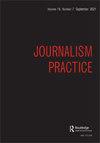失踪代表:研究种族如何影响围绕Gabby Petito失踪的失踪妇女的新闻报道
IF 2
2区 文学
Q2 COMMUNICATION
引用次数: 0
摘要
摘要:22岁的白人女性abby Petito在2021年9月的一次越野公路旅行中失踪。警方后来在怀俄明州发现了佩蒂托的尸体,并追查到她的未婚夫是她的死因,当时她正和佩蒂托一起旅行。佩蒂托失踪的每一个细节都通过大众媒体向全世界展示,但这种报道也受到了批评,因为它没有关注有色人种女性,她们在失踪时经常被忽视。这个内容分析的目的是比较Gabby Petito失踪的报道和大约在同一时间失踪的有色人种女性的报道,以检验在Petito受到如此多的批评之后,她们是否获得了更多的报道。调查结果显示,与失踪的白人女性相比,有色人种女性的故事、全国覆盖面和字数仍然更少。然而,在Petito案之后的几个月里,一些保险不平等有所改善。此外,过去文献中关于有色人种女性的有问题的叙述(例如,由于家庭暴力、吸毒和精神疾病等模式,她们经常被描述为有成为失踪人口的风险)很少在报道中被描述,这可能表明新闻报道中对待有色人种失踪女性的方式在短期内有所改善。关键词:白人女性失踪综合征;有色人种女性;新闻犯罪;新闻议程设置;框架;内容分析披露声明作者未报告潜在利益冲突。本文章由计算机程序翻译,如有差异,请以英文原文为准。
Miss(ing) Representation: Examining How Race Shaped News Coverage of Missing Women Surrounding Gabby Petito’s Disappearance
ABSTRACTGabby Petito, a 22-year-old white woman, went missing during a cross-country road trip in September 2021. Police later found Petito’s body in Wyoming and traced the cause of death to her fiancé, who was traveling with her. Every detail of Petito’s disappearance played out for the world to see through mass media, yet this coverage also received criticism for failing to shed light on women of color, who are often ignored when they go missing. The purpose of this content analysis was to compare coverage of Gabby Petito’s disappearance to women of color who went missing around the same time to examine whether they gained more coverage after Petito’s received so much criticism. Findings revealed that women of color still had fewer stories, less national coverage, and lower word counts than missing white women. However, some coverage inequity improved in the months following the Petito case. Also, problematic narratives about women of color from past literature (e.g., they are often described as at risk of becoming missing persons because of patterns like domestic violence, drug use, and mental illness) were rarely depicted across coverage, which may indicate short-term improvement in how missing women of color are treated in news coverage.KEYWORDS: Missing white woman syndromewomen of colorjournalismcrime newsagenda settingframingcontent analysis Disclosure StatementNo potential conflict of interest was reported by the author(s).
求助全文
通过发布文献求助,成功后即可免费获取论文全文。
去求助
来源期刊

Journalism Practice
COMMUNICATION-
CiteScore
5.50
自引率
14.30%
发文量
111
期刊介绍:
ournalism Practice provides opportunities for reflective, critical and research-based studies focused on the professional practice of journalism. The emphasis on journalism practice does not imply any false or intellectually disabling disconnect between theory and practice, but simply an assertion that Journalism Practice’s primary concern is to analyse and explore issues of practice and professional relevance. Journalism Practice is an intellectually rigorous journal with all contributions being refereed anonymously by acknowledged international experts in the field. An intellectually lively, but professionally experienced, Editorial Board with a wide-ranging experience of journalism practice advises and supports the Editor. Journalism Practice is devoted to: the study and analysis of significant issues arising from journalism as a field of professional practice; relevant developments in journalism training and education, as well as the construction of a reflective curriculum for journalism; analysis of journalism practice across the distinctive but converging media platforms of magazines, newspapers, online, radio and television; and the provision of a public space for practice-led, scholarly contributions from journalists as well as academics. Journalism Practice’s ambitious scope includes: the history of journalism practice; the professional practice of journalism; journalism training and education; journalism practice and new technology; journalism practice and ethics; and journalism practice and policy.
 求助内容:
求助内容: 应助结果提醒方式:
应助结果提醒方式:


